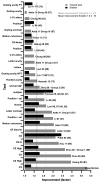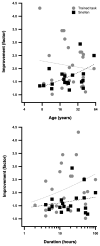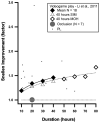Prentice award lecture 2011: removing the brakes on plasticity in the amblyopic brain
- PMID: 22581119
- PMCID: PMC3369432
- DOI: 10.1097/OPX.0b013e318257a187
Prentice award lecture 2011: removing the brakes on plasticity in the amblyopic brain
Abstract
Experience-dependent plasticity is closely linked with the development of sensory function. Beyond this sensitive period, developmental plasticity is actively limited; however, new studies provide growing evidence for plasticity in the adult visual system. The amblyopic visual system is an excellent model for examining the "brakes" that limit recovery of function beyond the critical period. While amblyopia can often be reversed when treated early, conventional treatment is generally not undertaken in older children and adults. However, new clinical and experimental studies in both animals and humans provide evidence for neural plasticity beyond the critical period. The results suggest that perceptual learning and video game play may be effective in improving a range of visual performance measures and importantly the improvements may transfer to better visual acuity and stereopsis. These findings, along with the results of new clinical trials, suggest that it might be time to reconsider our notions about neural plasticity in amblyopia.
Figures






Similar articles
-
Improving the performance of the amblyopic visual system.Philos Trans R Soc Lond B Biol Sci. 2009 Feb 12;364(1515):399-407. doi: 10.1098/rstb.2008.0203. Philos Trans R Soc Lond B Biol Sci. 2009. PMID: 19008199 Free PMC article. Review.
-
Perceptual learning as a potential treatment for amblyopia: a mini-review.Vision Res. 2009 Oct;49(21):2535-49. doi: 10.1016/j.visres.2009.02.010. Epub 2009 Feb 27. Vision Res. 2009. PMID: 19250947 Free PMC article. Review.
-
Can perceptual learning be used to treat amblyopia beyond the critical period of visual development?Ophthalmic Physiol Opt. 2011 Nov;31(6):564-73. doi: 10.1111/j.1475-1313.2011.00873.x. Ophthalmic Physiol Opt. 2011. PMID: 21981034 Free PMC article. Review.
-
Video-game play induces plasticity in the visual system of adults with amblyopia.PLoS Biol. 2011 Aug;9(8):e1001135. doi: 10.1371/journal.pbio.1001135. Epub 2011 Aug 30. PLoS Biol. 2011. PMID: 21912514 Free PMC article. Clinical Trial.
-
Perceptual learning in adults with amblyopia: a reevaluation of critical periods in human vision.Dev Psychobiol. 2005 Apr;46(3):222-32. doi: 10.1002/dev.20050. Dev Psychobiol. 2005. PMID: 15772964 Review.
Cited by
-
The burden of pure anisometropic amblyopia: a cross-sectional study on 2800 Iranians.Int Ophthalmol. 2018 Feb;38(1):29-34. doi: 10.1007/s10792-017-0784-z. Epub 2017 Dec 13. Int Ophthalmol. 2018. PMID: 29236204
-
Effects of video-game play on information processing: a meta-analytic investigation.Psychon Bull Rev. 2013 Dec;20(6):1055-79. doi: 10.3758/s13423-013-0418-z. Psychon Bull Rev. 2013. PMID: 23519430
-
Assessing Previous Strategies and Presenting a Novel Smart Glasses to Enhance Adherence to Amblyopia Therapy in Children.Patient Prefer Adherence. 2025 May 21;19:1497-1508. doi: 10.2147/PPA.S504566. eCollection 2025. Patient Prefer Adherence. 2025. PMID: 40421074 Free PMC article. Review.
-
Recovering stereo vision by squashing virtual bugs in a virtual reality environment.Philos Trans R Soc Lond B Biol Sci. 2016 Jun 19;371(1697):20150264. doi: 10.1098/rstb.2015.0264. Philos Trans R Soc Lond B Biol Sci. 2016. PMID: 27269607 Free PMC article.
-
Perceptual learning: toward a comprehensive theory.Annu Rev Psychol. 2015 Jan 3;66:197-221. doi: 10.1146/annurev-psych-010814-015214. Epub 2014 Sep 10. Annu Rev Psychol. 2015. PMID: 25251494 Free PMC article. Review.
References
-
- Ciuffreda KJ, Levi DM, Selenow A. Amblyopia: Basic and Clinical Aspects. Boston: Butterworth-Heinemann; 1991.
-
- Kiorpes L. Visual processing in amblyopia: animal studies. Strabismus. 2006;14:3–10. - PubMed
-
- Levi DM. Visual processing in amblyopia: human studies. Strabismus. 2006;14:11–9. - PubMed
-
- Wu C, Hunter DG. Amblyopia: diagnostic and therapeutic options. Am J Ophthalmol. 2006;141:175–84. - PubMed
-
- Morishita H, Hensch TK. Critical period revisited: impact on vision. Curr Opin Neurobiol. 2008;18:101–7. - PubMed
Publication types
MeSH terms
Grants and funding
LinkOut - more resources
Full Text Sources
Medical

